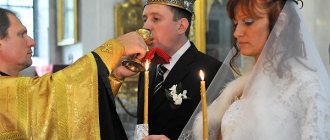Features of the sacrament of church wedding in the Orthodox Church. Choosing a date, outfit, witnesses.
- God brings people together. It is in his power to compile the whole picture of our fate, “chance” meetings, trials and sorrows.
- Before the Bolsheviks came into power, our ancestors respected church canons and were very sensitive to the sacrament of marriage. There was no question of any cohabitation or civil union; all this was considered a shame and was not welcomed in society
- All the Holy Scriptures say that man was created by God, that is, He is our father and progenitor, who made all people akin to each other
- This means that without his will, blessing and kind parting words, starting an important business means dooming it to failure in advance. This is probably why our ancestors revered their older family members so much and did not marry without their permission and approval.
The meaning of a wedding in the Orthodox Church?
young people hold candles during the wedding
- Even if you consider yourself not a religious person and don’t go to churches, you still feel that a wedding is a serious step for spouses
- The priests say that at the moment of their wedding, a young couple lets Jesus Christ into their family. He protects them from adversity and disagreement, strengthens it if both spouses are faithful to each other
- In the face of the Holy Icons and God, people cement their union, merge together, turn into a single whole
- The young couple thus receives the blessing of the Almighty and undertakes to fulfill his commandments
- Those who have undergone the sacrament of wedding note that they felt spirituality during the ceremony and even greater closeness with their loved one
What does the Sacrament of Marriage mean in church language?
“A man will leave his father and mother and cleave to his wife; and they will both become one flesh” (Gen. 2:24)
What do you need to understand before going to the Sacrament of Wedding?
- This is, precisely, a quiet and modest family holiday, and not a wedding; without it, the family is not considered complete according to church customs. By this action you legitimize your marriage there, “in heaven,” so it’s worth getting acquainted with these laws.
- To undergo the Sacrament of Wedding, the mutual consent of both parties is necessary; you need to consciously approach this very important event in the life of the family.
- The couple receives a blessing through the priest from the Lord God himself and for “the entire subsequent life” both on Earth and in Eternity, and becomes a full-fledged family according to all church canons.
- The couple makes an unbreakable vow to be together forever: in sorrow and in joyful events, to raise children together, and to earn money together for the well-being of the family. Absolutely everything is divided into two.
- You need to prepare very well spiritually for the Sacrament of Marriage. Before the wedding, you must come to the Temple and talk with the priest. He will talk about special preparations and at the same time check the couple’s readiness for the wedding. And even if he initially refuses the wedding, you shouldn’t be upset. This is a very good reason to think about it once again and start preparing.
- The priest always helps to choose the day for the Betrothal and the Sacrament of Marriage. The Sacrament of Marriage is never planned during four fasts: Great, Nativity, Dormition and Apostolic.
- Also, the wedding ceremony is not performed during Easter week, Cheese week, from Christmas until the feast of Epiphany (Epiphany).
There are still exceptions when a wedding CANNOT be performed:
- On Saturday, before church and temple holidays the day before, because you cannot rejoice in advance, you need to remain in prayer.
- Weddings are also not celebrated on Tuesday and Thursday, because these days come before Lent on Wednesday and Friday.
- And also on the eve and on the very feast of the Beheading of John the Baptist and the Exaltation of the Cross of the Lord.
However, only the bishop can make any exceptions on a special occasion.
Wedding rules
beautiful couple getting married
- You should inform the priest about your intention in advance. Consult with him on all issues that concern the minds of the young couple
- The wedding date should not be chosen during fasting
- Christians are married if they were baptized in the church and are not in another marriage. Between representatives of different faiths, for example, Muslim, Buddhist, a wedding in the Orthodox Church is impossible
- Clothing for this sacrament is chosen to be elegant and light in color. For women, long sleeves, closed shoulders, back or the use of a cape covering them are desirable
- Before the ceremony, a betrothal takes place in the church, when the newlyweds are given a period of time to confirm their intention to link their destinies.
- Photo and video filming of the wedding ceremony in the church is allowed, the main thing is to discuss this point in advance with the priest
- The wedding is held for those who have reached the age of 18 and registered the marriage in the registry office
- It is permissible to carry out the wedding ceremony of a person three times in his entire life if he is widowed or his marriage was dissolved with the consent of the church
- The priest will refuse to administer the sacrament to close relatives
- On the eve of the wedding date, the young couple observes fasting and confesses to the priest.
The meaning of the sacred ritual
Orthodox Christians greatly honor marriage concluded in the presence of the Lord God, considering this union more important than the state one. Having received God's blessing, the newlyweds enlist the support of the Almighty in a married life full of love, mutual understanding and fidelity.
Today, newlyweds are increasingly confirming their official marriage with vows before the Lord God
The meaning of the sacrament is that a married couple continues to be such in Heaven, remaining inseparable even after death. Having made a marriage vow, the newlyweds seal themselves with sacred bonds, gaining Divine protection.
How to prepare for a wedding in the Orthodox Church?
serious faces of the newlyweds during the wedding
Before starting the Holy Sacrament for marriage, you should consider and fulfill several points:
- choose the right date. The church has its own schedule and life, therefore weddings are not held during fasting and holidays
- decide on the temple where the wedding will take place
- negotiate with the priest who will conduct the service. This could be your confessor from another church/cathedral
- prepare a set for the wedding. By the way, you can buy it ready-made in a church shop
- rings. Some time ago, a young couple brought one gold and one silver ring. The first symbolizes the sun and male energy, the second symbolizes the moon, female energy. And the ritual itself was considered the union of two creative principles into one for the birth of a new life
- choose your outfit carefully. Usually this is the dress that was worn on the day the marriage was registered at the registry office. But many couples come to the desire to get married consciously later. Then a different outfit is chosen. For women, long-sleeve, floor-length dresses and a scarf on the head are optimal.
- be sure to come to confession the day before and take communion, and observe the required duration of fasting
For whom is the ritual prohibited?
In Russia, clergy do not have the right to perform a ceremony without first registering a marriage with government authorities. There are several other situations when weddings are prohibited:
- the newlyweds have not reached the age of majority;
- one of the couple changed gender;
- young people are relatives by blood or spirit;
- one of the spouses is not divorced at the time of the ceremony;
- atheists, adherents of another faith, or unbaptized people want to get married;
- people who have taken a vow of celibacy;
- incompetent;
- the husband or wife has had three or more divorces.
But for pregnant women it is not only possible, but even necessary, because the baby must be born in a divine union.
How to choose the best days for a wedding?
choose the wedding date according to the calendar
As noted above, a church or temple has its own daily routine, in which there are days only for prayers and divine services of monks. For example, during fasting, great holidays known in the world, the wedding ceremony is not held.
Each temple has its own schedule for the whole year in advance. You can get acquainted with it when you come to the priest to agree on a date.
An approximate wedding calendar for 2016 is presented here, and for 2022 - here.
When can you get married?
The modern Orthodox Church holds wedding sacraments only on certain days, which those wishing to get married must discuss in advance with the clergyman of the chosen church.
In fact, the Russian wedding ceremony can take place on any days except:
- days on which multi-day fasts occur
- the week that falls before Lent (we are talking about Maslenitsa week)
- the week falling before Easter
- You cannot get married during the Christmas season: from Christmas to Epiphany
- Saturday, Thursday and Tuesday are days when weddings are not held, even if there is no fasting
- It is prohibited to get married the day before any church holidays and on the holidays themselves
In addition, on the chosen day for the wedding you still need to choose a time. Churches do not have weddings earlier than 14:00 and later than 17:00. A prerequisite for the wedding sacrament is a bright day. After all, after the ceremony, the clergyman will still have to conduct a service.
What is needed for a wedding in the Orthodox Church?
icons for wedding
Before the wedding ceremony, a young couple should:
- come for an interview with the priest, discuss the date of the sacrament with him
- follow all his instructions regarding the post
- agree on the day the young couple will come for confession and communion
- talk about the engagement - will it be held several months before the wedding or will it precede the last one on the same day
On the day of the sacred sacrament, the young couple prepares:
- icons of the Savior and the Virgin Mary, perhaps they are passed down as a relic in one of the families from parents to children
- pectoral crosses
- rings
- special wedding candles. They can be purchased locally at the church store
- towel under your feet
- towel or cloth for tying hands
- handkerchiefs for holding candles and crowns, 4 pieces in total
- bread, wine, sweets
Many churches also require two witnesses who will hold the crowns over the wedding couple and help in the process of performing the sacrament. These people are selected from among baptized Christians who regularly attend church services.
Witnesses
First of all, these are people who help those getting married at the ceremony itself. They hold crowns over the heads of the couple, accompany them during the three-fold procession, spread a towel in front of the lectern at the feet of the newlyweds, present rings and collect the donated flowers after the completion of the Sacrament.
In most cases, spouses choose either relatives or close friends as witnesses. Those who agree to such a role become spiritual relatives, who will then no longer be able to marry each other in the future. For a couple, they are like mentors. That is why you should approach your choice with all responsibility.
It is impossible for the witnesses to be unbaptized or of a different religion, unless, of course, you want to follow all the rules.
It is not recommended to take:
- parents;
- people who live in an unregistered marriage. This is explained by the fact that the church does not welcome such unions;
- divorced people, because those who were unable to maintain their own happiness are unlikely to be advisors to anyone.
If there are no suitable candidates in your circle, then it is better to do without witnesses at the wedding. The main thing is to inform the priest who will conduct the ritual about this in advance.
What kind of wedding rings are needed?
wedding rings in a box
- More than 10 centuries ago, the tradition of betrothal on the eve of the wedding developed. Both of these sacraments were performed only before the face of God in church
- Closer to our time, registration of marriage in the registry office began to be considered betrothal. Some couples believe that this act is enough to create a new family, while others do not. They either, under the influence of fashion, pressure from parents, personal mutual desire, come to church to get married
- According to church canons, wedding rings are different from engagement rings. The second is a symbol of the desire to reunite in the union of two people. Externally, they can be anything, including expensive options with precious stones
- Wedding rings are more modest and simple jewelry. On their inner side, our ancestors carved prayers, and we carved the wedding date and the name of the spouse
- Correctly chosen rings - gold for the husband, silver for the wife. The first personifies Jesus Christ and Divine power, the second - the Church, purity, loving service
Basic Rules
List of necessary things for the ceremony
- Marriage registration document . If you were previously married, then a divorce certificate .
- Illuminated rings . In ancient times, there was a tradition according to which the man brought gold jewelry to the temple, which symbolized the sun and God, and the girl brought silver jewelry, which symbolized the moon and the church. After the three-fold exchange, the bride was left with an item made of gold, and the groom – with silver. In the modern world, priests allow you not to follow such canons and choose accessories to your taste, the main thing is that it is not costume jewelry. It is recommended to select more modest models, without huge brightly colored stones and other eye-catching decor. After all, spouses should perceive wedding rings not as beautiful trinkets, but as a symbol of their love. The ideal solution would be: paired, smooth, engraved with names, wedding dates or prayers, with a small diamond or rings. You are also allowed to use your own wedding rings, provided, of course, they comply with the listed rules.
- Orthodox icons - Christ and the Mother of God, which are needed to bless you.
After the Sacrament, be sure to keep them, because they are intended to protect your family life. Advice. A good idea is to take icons of your parents. - Large candles and two small white scarves - for the newlyweds and two of the same scarves for witnesses at the wedding.
- Two towels or towels. It is better that they are large, because according to tradition, the newlyweds will have to stand on one of them. The second one bandages his hands.
- A bottle of red wine, preferably Cahors . His lovers will drink from the same cup during the ceremony.
What needs to be done before the Sacrament
For spiritual cleansing, three days before the sacred ceremony, you must abstain from dairy, meat and fish products, as well as eggs, alcoholic beverages and cigarettes. In other words, fast .
Refrain from both intimacy and fun events these days.
According to the rules, on the eve of the wedding, the husband and wife will need to confess . This happens very simply: come to the cathedral and tell the priest about all your sins. He, in turn, acts as an intermediary between you and the Almighty. Try not to be shy about this procedure and not to hide anything. After all, only if you are truly honest and sincere, will God hear you and forgive all your actions. Thus, you will enter into a spiritual marriage sinless and renewed.
The night before the ceremony, after 12, you will have to deny yourself food. Since in the morning, before the Sacrament, you have to attend the liturgy and receive communion there . Father will give you a spoonful of wine and a piece of church bread.
Communion and confession are impossible without each other.
Appearance
The bride and girls present in the Orthodox church must have their heads covered. In the case of a newlywed, this could be a veil, a hood from a cape or bolero, a stole and much more. It is appropriate for guests to wear scarves.
All women should cover their shoulders, back, décolleté and knees. The bridegroom needs to choose the most chaste outfit possible. A wedding dress should not be too revealing, tight, mini-length, pretentious, or with a lot of decor.
Also avoid black, brown and other dark colors. After all, within the walls of the cathedral this is usually regarded as mourning. Any calm light shade will do:
- ivory;
- light pink;
- heavenly;
- peach;
- tea rose;
- beige;
- cream;
- honey;
- pale yellow and so on.
Save catchy and acidic tones, such as red, green and lemon, for another occasion.
The bride is also not recommended to wear bright makeup. The ideal solution would be a modest nude and lip gloss. Jewelry should be kept to a minimum, and it’s better not to wear anything on your hands at all. On this day, let your wedding ring be the main thing.
Shoes should be chosen that are comfortable for both the young people and their guests. After all, the Sacrament lasts about an hour and you will need to stand all this time.
For the groom and invited men, the rules are much simpler than for girls. The main thing is to enter the cathedral without hats. For the bridegroom, a classic suit or shirt and trousers is quite suitable. The main thing is that the color of the fabric is not flashy, and the style is not non-standard.
All those present at the ceremony must wear crosses.
How to behave in the temple
- You can’t be late for the ceremony, it’s better to come a little earlier;
- Orthodox Christians must be baptized with their right hand, do not forget about this rule;
- Women stand on the left side, men stand on the right. It is worth warning your guests about this so that they take the correct seats before the start of the Sacrament, because they will not be allowed to walk during the procedure;
- Cell phones must be turned off at a wedding and not be distracted by them;
- stand facing the iconostasis;
- For photo and video shooting, please agree in advance with the priest.
How to choose a dress for a wedding in the Orthodox Church?
The correct wedding dress for the bride
Perhaps this is the most exciting and sensitive question for every bride. After all, she wants to be the most irresistible and beautiful on her wedding day.
What should be included in a bride's outfit:
- dress or skirt below the knees
- closed shoulders, chest, back. For open styles of wedding dresses, take a cape
- the head is covered with a veil, scarf, hat
Find out more about the nuances of choosing a wedding dress here.
How is a wedding carried out in the Orthodox Church?
young couple before the wedding
- The sacrament of the wedding begins with the engagement, if the young couple arrived at the church after the registry office. Liturgy is going on in the church all the time
- The priest meets them at the entrance and leads them inside. In this case, the newlyweds are positioned like this - the man is on the right, the woman is on the left, and both are turned to face the altar
- The deacon brings out the engagement rings on a tray, which were prepared in advance and lay on the altar
- The priest makes the sign of the cross to the young couple with the help of lit wedding candles and hands them to them. This is a symbol of the meeting of two loving hearts who want to link their destinies together.
- Next, the priest invites the newlyweds to put on the rings, reading special prayers and voicing their intention to get engaged. He makes the sign of the cross over each of the couple - first the man, then the woman, and he himself puts the rings on them. Afterwards, the bride and groom exchange rings as a sign of their readiness to share their joys and sorrows with each other
- Then the young couple stands on a towel, which means their desire to have one destiny for two. They confirm this three times, answering the priest’s question, that they did not promise their heart to anyone else.
- Prayers are read and the service continues. Everyone present in the church prays with the priest for the happiness of the young
- Then the crowns are brought out and the priest first makes the sign of the cross over the young people and places them on their heads. The crown can be held above the bride by a witness due to her voluminous hairstyle
- The priest ties the young people’s right hands with a towel and leads them around the lectern three times
- Then the deacon brings wine in a cup, over which the priest reads prayers and offers the man and woman to drink three times in turn.
- Having joined his right hands together and covered them with his stole, the priest again leads the young couple in a circle three times. Leads to the golden gate, where they take turns kissing the icons of the Savior and the Virgin Mary
- At the end of the wedding, the priest gives a cross for kissing to the husband and wife and hands them the icons with which they were married. Newlyweds can hang them above their bed to maintain a constant connection with the Almighty
The first part of the sacrament is betrothal
It aims to instill in the newlyweds the importance of the sacrament of marriage, to evoke awe and reverence in their hearts for this event.
Blessing
Initially, the “new brides” are located in the vestibule - an extension in front of the entrance to the temple, which is usually separated from the temple itself by a wall with a doorway.
The groom stands on the right, the bride on the left, both turn to face the altar. Wedding rings are placed on the altar table in advance and are kept there during the liturgy. When the wedding ceremony begins, the deacon, following the priest, carries them out on a special tray.
The priest, depicting Jesus Christ at this moment, approaches the newlyweds (they, in turn, are equated to the primordial ancestors Adam and Eve, beginning a new and holy life in a pure marriage), holding two burning candles in his hands - a symbol of purity and chastity .
He blesses the groom three times and the bride three times, repeating: “In the name of the Father, and the Son, and the Holy Spirit” (the young are baptized each time), hands them candles (or does not hand them over if one of those entering into marriage is getting married not the first time).
The blessing ends with a cross-shaped incense, which speaks of the invisible presence of the grace of the Holy Spirit at the sacrament .
Engagement
After the blessing, the priest leads the newlyweds to the center of the temple.
Taking the groom's ring , he repeats three times: “The servant of God (name) is engaged to the servant of God (name) in the name of the Father, and the Son, and the Holy Spirit,” each time making the sign of the cross over the groom’s head, and then puts the wedding ring on his ring finger right hand. By the way, we have already written on which hand representatives of various faiths wear rings on.
The priest performs the same actions with the bride’s ring , repeating three times: “The servant of God (name) is betrothed to the servant of God (name) in the name of the Father, and the Son, and the Holy Spirit.”
Exchange of rings
The newlyweds exchange their rings three times, thereby expressing agreement and unanimity and promising to give themselves to each other for life. The priest himself can change the rings. During the ceremony, he also turns to the Almighty several times in prayer, asking the Lord to bless the newlyweds and confirm the engagement.
Weddings in the Orthodox Church: signs
the newlyweds enter the middle of the temple for the wedding
- Before the wedding ceremony, no one should see the face of the bride, not even the groom. A thick veil was used for this. Nowadays, the bride's face is covered with openwork or more transparent headlights/scarves
- After the bride left for the wedding, the floors in the house where she lived were washed so that she would not return home and her family life would be happy
- If during the sacrament of a wedding someone drops the crown, he must be widowed
- During the ceremony, those getting married should not look into each other's eyes. This promises a short period of love and betrayal
- According to signs, rings should be smooth, without stones or inscriptions, so that the life of the young people will be smooth and okay
- If the wedding candles crackle loudly during the ceremony, the life of the young couple will be difficult
Traditions and rituals
All traditions associated with the sacrament of weddings are designed to protect newlyweds from evil spirits that could disrupt the concluded union. Thus, the towel on which the newlyweds made their marriage vows should be kept at home and not given to anyone else, because it symbolizes the life path of a young family.
At the end of the ritual, it is customary to bring a symbolic gift to the temple in the form of fresh bread wrapped in a new linen towel. After the ceremony, it is advisable to store wedding candles next to the towel and light them only when absolutely necessary.
A wedding ring falling on the floor during the ceremony is considered a bad omen. As a rule, such an event promises a quick divorce or the premature death of one of the spouses.
After the ceremony, it is advisable to store wedding candles next to the towel
Wedding ceremony in the Orthodox Church: reviews
happy husband and wife after the wedding
Polina and Victor, young family
We got married a year after the wedding ceremony at the registry office. We came to this step consciously, regularly attended church services and communicated with our spiritual father. We received permission to film the ceremony. Surprisingly, while watching, we saw that at a certain point we became similar in appearance to each other. And in everyday life, many acute moments began to smooth out. We felt that the Higher Powers were supporting us and giving us inspiration to overcome all the twists and turns of fate.
Galina and Evgeniy, family with 10 years of experience
We got married immediately after the wedding ceremony at the registry office. It was more a tribute to fashion than our conscious decision. We went through a lot of difficulties and trials, we were on the verge of divorce three times. But they stayed together. We believe that God decided to bind us tightly together and helped us overcome all the challenges of fate. For this we are immensely grateful to him!
Stages of the ceremony
The sacrament of marriage can be divided into four parts:
- Engagement.
- Wedding.
- Resolution of the crowns.
- Thanksgiving prayer.
In addition, every wedding is preceded by the Divine Liturgy, at which the bride and groom must be present in order to properly tune in to the upcoming event, feel its solemn atmosphere and pray for the strength to build a strong family. If the future spouses have not done this before, after the service they will also need to confess and receive communion.











